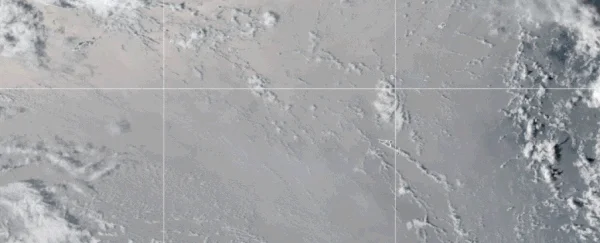
Undersea volcanic eruptions constitute over 75% of global volcanic activity, yet their impacts are seldom witnessed firsthand.
The eruption of Hunga Tonga-Hunga Ha’apai in 2022 proved to be a remarkable exception, breaking the ocean surface with a forceful explosion that pierced through the stratosphere. This event generated supercharged lightning and an atmospheric shock wave that encircled the globe multiple times, as documented in various reports, such as NASA’s Earth Observatory.
While satellite imagery captured the external aftermath, a recent study delves into the submerged impacts of the Hunga-Tonga eruption. The research, led by Sarah Seabrook, a marine biogeochemist at the New Zealand National Institute of Water and Atmospheric Research, reveals the extensive damage inflicted on the seafloor, undersea cables, and marine life.
Seabrook emphasizes, “The eruption causes dramatic changes to nutrient and oxygen levels in the water which could have feedbacks that we are yet to understand”.
The study, published in Nature, compares seafloor mapping surveys conducted post-eruption with data from 2015-2017. The findings underscore the hidden yet substantial consequences of undersea volcanic events, including widespread loss of marine life and damage to critical seafloor telecommunication links.
Seabrook and her team utilized various data sources, including ship-based sonar, sediment cores, geochemical analyses, water column samples, and video footage, to analyze the powerful upheaval unleashed by the 2022 Hunga volcano eruption.
The study highlights the inadequacy of current submerged volcano mapping, describing it as a “major blind spot” in risk assessment and preparedness, especially for shallow-water volcanoes near populated islands.
The analyses reveal the loss of at least 6 cubic kilometers of seafloor from within the caldera, a volume 20 times greater than the 1980 Mount St. Helens eruption. Additionally, 3.5 cubic kilometers of material were ejected from the volcano’s submerged flanks.
To contextualize, previous studies estimated that 1.9 cubic kilometers of material were ejected into the atmosphere during the Hunga Tonga-Hunga Ha’apai eruption. This implies that approximately 80% of the ejected material remains in the ocean, contributing to fast-moving density flows that carved deep tracks in the seafloor and accumulated significantly in certain areas.
Video footage reveals vast desolate areas on the seafloor near the caldera, lacking marine life or covered in ashfall, just three months after the eruption. Encouragingly, wildlife refugia on adjacent seamounts, sheltered by the topography, offer optimism for the gradual recovery of seafloor communities.
The discovery of fine volcanic ash has resulted in the murkiness of the water column at depths of 200 meters, extending up to 20 kilometers from the caldera. The potential persistence of these plumes raises concerns about unforeseen impacts on the food security of Pacific Island nations.
“Future monitoring, of both the volcanic edifice itself and the surrounding seafloor and habitats, is necessary to robustly determine the resilience and recovery of both human and natural systems to major submarine eruptions,” says Seabrook.
Recalling the 2012 incident, scientists narrowly missed detecting the most substantial deep-ocean eruption on record, originating from the Havre Seamount in the Kermadec Islands, stretching northward from New Zealand towards Tonga. While attention is now directed at these incidents, approximately 100,000 uncharted undersea volcanoes persist in the abyss.
The comprehensive study has been documented in Nature Communications. Read more.





